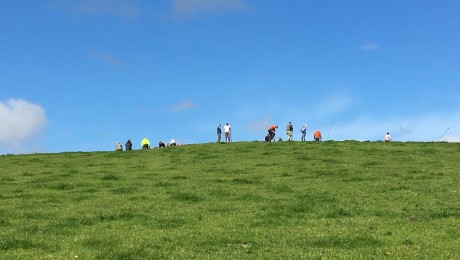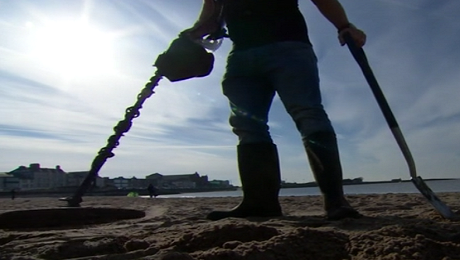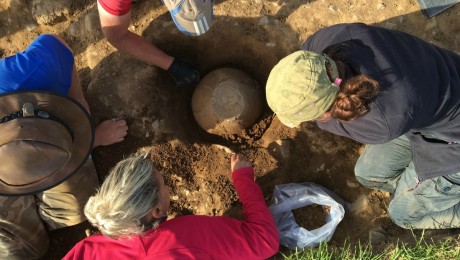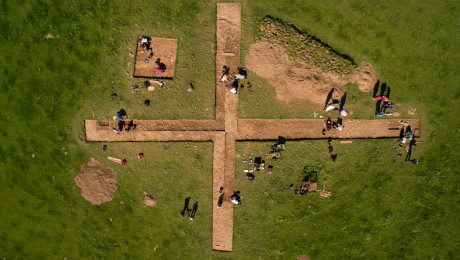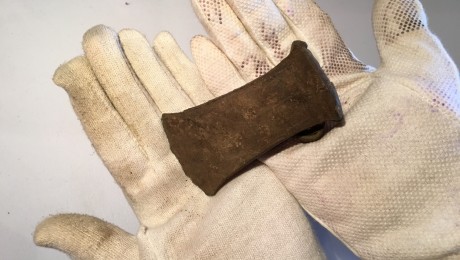Until now, historians have had very little evidence about the people who lived in North West England during the Bronze Age. But then came the discovery of two spectacular treasure hoards, and with it, two Bronze Age monuments and the populations that built them.
1. The Morecambe Hoard
One fine day, metal detectorists Matthew Hepworth and David Kierzek headed out to survey a small unassuming hill in a field overlooking Morecambe Bay. It’s a field they’d surveyed dozens of times before, but this time was different.
Their detectors uncovered a Bronze Age hoard, consisting of a bronze tanged chisel and knife blade, concealed just beneath the surface of the hill. They immediately reported their findings to the Portable Antiquities Scheme, and in doing so, sparked the rare and exciting opportunity for further investigation.
The artefacts
Both the chisel and knife are well preserved and date from the Middle to Late Bronze Age (1,000BC-800BC).
Following the initial discovery in 2013, the University of Central Lancashire and the Portable Antiquities Scheme did a small-scale investigation to verify the finds and assess the need for a further full-scale excavation. The result? More finds (such as jet fragments and pieces of worked flint), a circular arrangement of stones containing cremated bone and charcoal, and clear confirmation that the two detectorists had found something of great significance.
The monument
Finds like this are uncommon in the North West of England, and their presence suggests that there may even be a rarer undisturbed burial hidden nearby. The evidence gathered so far identifies the site as a prehistoric burial mound, or round barrow, likely in use from the Late Neolithic period until the Middle to Late Bronze Age (2,500BC-800BC). That’s an incredible 1,200 years of history just waiting to be revealed.
2. The Lancaster Hoard
In 2016, DigVentures set about investigating the find spot for the Morecambe Hoard. While the team was out in the field, news came through of another astonishing discovery, just a few miles away: another Bronze Age hoard.
The artefacts
DigVentures was called in to take a look at the discovery, and its location. This hoard was found to contain spearheads, axes, bracelets, arm rings, a chisel, a pair of ornaments and, stuffed inside one of the axes, an almost perfectly preserved Bronze Age flower.
Nothing quite like it has ever been found in the region, and experts are calling the most spectacular discovery of its kind in North West England.
The monument
From having little evidence to go on, to having two treasure sites just a few miles apart, it’s clear that there is an entore Bronze Age history of North West England is just lurking below the surface.
For just like the Morecambe Hoard, it seems that the Lancaster Hoard is not an isolated find – the place where it was found actually appears to be the site of another Bronze Age monument.
Knowledge is treasure
During the 18th and 19th centuries, antiquarians dug into many Bronze Age monuments mistakenly believing that they contained treasure. As a result, finding an intact barrow, like the one in Morecambe, is very unusual.
In reality, high status objects aren’t often found within barrows, and we’re not expecting to find anything of monetary value during our dig. But, as metal detectorist Matthew quite rightly says, it’s not a treasure hunt:
‘It’s about learning about the past. It’s part of our heritage, and the biggest thing of value to come from this find is the knowledge.’
As an example of how responsible metal detectorists can form an integral part of archaeological investigations, both Matthew and David have been working closely with the DigVentures team ever since.
A fantastic opportunity
This ground-breaking project is made possible due to the support of the Heritage Lottery Fund (HLF) and a community of interested parties. Ever since the finds were first reported to the Portable Antiquities Scheme (PAS), DigVentures have been heavily involved in the project’s conception and development, working closely with both PAS and the HLF to design this innovative scientific investigation.
A key part of the project aims to involve as many people in the local community as possible, encouraging their interaction across all parts of the excavation and post-excavation process. In addition to the vital data contained within the barrow, in many ways, the real ‘treasure’ of this project is the huge opportunity that Matt and David’s discovery has created for local people to rediscover their own heritage.
This site could prove to be one of the last surviving unexcavated barrows in the region, making our in-depth study all the more crucial…
